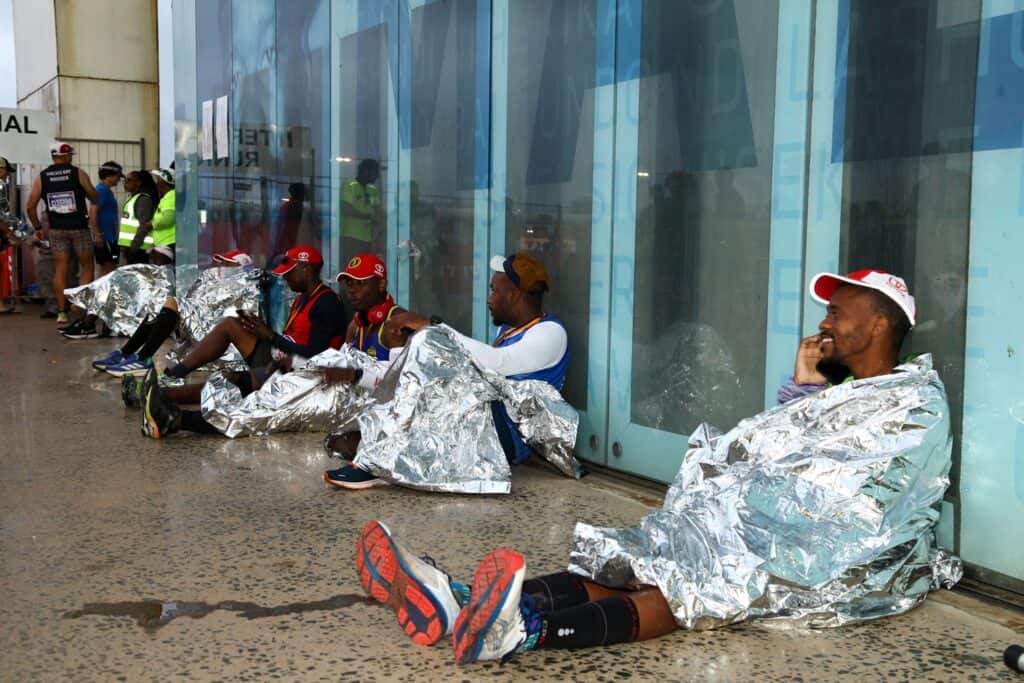If you’re training for the Comrades Marathon then get ready to unlock your true potential…
In this article, we offer insights and strategies to help participants excel in the Ultimate Human Race.
We’ll cover training, nutrition, injury prevention, mental preparation, and race-day strategies.

Which Days Of The Week Should You Do Your Strength Sessions?
When planning your strength/gym sessions while training for the Comrades Marathon, it’s important to consider your rest days and overall recovery.
To optimize your training, I recommend incorporating some of the program’s designated rest days.
However, it’s crucial to have at least one day per week where you refrain from exercising entirely, allowing for complete recovery.
If your weekly schedule permits, you can still include strength training on one of your running days, as long as you avoid scheduling it on long-running days or days involving intense running.
Additionally, it’s essential to have a minimum of one rest day between two gym days, ideally two, to give your body ample time to recover and rejuvenate.
Comrades Marathon Silver Medal – What Should You Be Doing?
For those aiming to achieve a silver medal in the Comrades Marathon, it’s a critical time for training. To be considered in this elite category, you must be an exceptional runner with extensive training, including completing a sub-3-hour marathon.
However, the focus now shifts to building the necessary confidence rather than solely chasing that time. It’s crucial to prioritize conditioning yourself to a level where you feel capable of achieving the sub-3-hour mark if you were to race it. If you haven’t already secured an ‘A’ seeding, it’s not advisable to pursue it now.
Instead, the current goal should be to participate in slightly shorter races, such as 21 or 32km, to work on improving speed and build the confidence needed.
This preparation sets the foundation for a strong March and April, which will involve rigorous training and increased mileage, along with a focus on strength training to tackle the challenging Comrades Marathon.
As someone personally aiming for a silver medal, my weekly mileage gradually increases from 80 to 100km, incorporating quality workouts. By the end of March, I aim to reach 100 to 110/115km per week, fully dedicated to preparing for the demanding race ahead.
Get FULL access to the Comrades Training Roadmap now!
Comrades Marathon Training Over The Festive Season
Let’s delve into the strategies for Comrades Marathon runners to stay on track during the festive season.
With the holiday season approaching, it becomes easy to deviate from training and indulge in excessive eating and drinking.
To ensure runners reach January without gaining unnecessary weight and maintain their training momentum, here are some valuable tips.
It’s important to acknowledge that December can be challenging for most individuals in terms of weight management. Some may even go to the extreme of overtraining due to the abundance of free time. However, it is crucial to find a balance to avoid reaching the Comrades Marathon fatigued or at risk of injury.
During December, it’s advisable to maintain a sensible approach and not skip too many training sessions. Aim to train consistently, ideally three to four days a week.
To maximize your efforts, schedule your runs early in the day, preferably in the morning. By doing this, you can take advantage of the quietness in the house and complete 8 to 15 kilometers.
Following this routine three to four times a week, even with some indulgence, will help you stay in check. As January approaches, you’ll find yourself in a better position to continue your training and easily shed the additional weight gained during the festive season.
The key message is to exercise moderation and ensure you do some training rather than none at all.

“Constant Injury Niggles Are Hampering My Comrades Marathon Training”
In a recent follow-up inquiry, an individual training for their first Comrades Marathon sought advice regarding recurring injuries.
They had previously discussed a calf injury and subsequent knee discomfort with us, following our recommended rest and gradual return to the training program. However, upon reaching a full week back on the program, the individual experienced a resurgence of sore knees, forcing them to cut short a 5km walk.
Additionally, they expressed frustration over hip pain and the perceived setback in their Comrades training progress. Despite being fit and following a strict run/walk regimen since June, they were uncertain about the cause of these issues and sought further suggestions.
We noted the potential need for the individual to complement their current routine with proper strength training.
Biomechanical factors were identified as probable contributors to the recurring niggles. Given the individual’s gradual approach and previous adjustments to their training, we recommended a comprehensive biomechanical evaluation.
This analysis could involve consulting a podiatrist, ensuring suitable footwear, or exploring interventions such as orthotics or shoe inserts to address any significant biomechanical concerns.
To receive appropriate guidance, we encouraged the individual to reconnect with us, as we could potentially recommend local healthcare professionals for further assistance. By undergoing a thorough biomechanical assessment, they could ascertain whether they are wearing the correct shoes and address any imbalances through targeted strength training. This process aims to optimize their muscle strength and potentially resolve the issues before November, allowing ample time to prepare adequately for the Comrades Marathon.
Acknowledging the individual’s patient and disciplined approach to training, their commitment, and existing fitness level provide advantages.
By prioritizing short-term interventions and focusing on strengthening their muscles, they can increase their readiness for the upcoming race.
The key takeaway from this discussion is the importance of seeking professional advice, prioritizing biomechanical evaluations, and addressing any potential issues or concerns with footwear. By following these steps, individuals can optimize their training and enhance their chances of a successful Comrades Marathon performance.
Cross Training and The Comrades Marathon: Will It Help?
A question was posed regarding cross-training as a substitute for the early months of the training program for the Comrades Marathon.
The individual explained their ongoing recovery from proximal hamstring tendinopathy and their current routine involving gym exercises and cycling. They sought advice on whether this cross-training would be sufficient to gradually increase their running by a certain month.
Considering the person’s extensive experience with 14 Comrades Marathon medals, we responded that cycling serves as effective cross-training to maintain overall fitness.
We advised incorporating strength exercises and cautioned against rushing the process.
Instead, we recommended a steady progression, leading up to a marathon qualifier without aiming for a fast time.
When preparing for a demanding event like the Comrades Marathon, incorporating cross-training into your training routine can yield significant benefits.
In a recent discussion, we addressed the question of integrating an Ironman 70.3 into Comrades Marathon training.
We emphasized that cross-training activities such as cycling and swimming can help build core strength and stamina without subjecting the body to the same level of impact and potential injury as running alone.
We explained that while running remains an essential component, there is a point where adding more running sessions does not necessarily lead to improved performance.
In fact, it may increase the risk of injury. Cross-training plays a vital role in allowing athletes to strengthen their bodies while minimizing damage and reducing the chances of getting hurt.
Training for an endurance event like an Ironman alongside the Comrades Marathon can be a wise strategy.
We recommend slightly increasing the volume of running compared to an Ironman-focused training plan, while still maintaining a balanced mix of cycling, swimming, and running throughout the training program.
This approach helps ensure athletes are both strong and fit for the challenges of the Comrades Marathon.

Cruising To a Comrades back2back Medal
In a recent discussion, a passionate runner shared his experiences and challenges as he pursued his running goals while working on super yachts and traveling the world.
Finding Balance in a Nomadic Lifestyle:
The runner’s life as a crew member on super yachts took him to various locations around the globe, presenting unique challenges for maintaining a consistent running routine.
However, the runner’s commitment to running marathons and accomplishing specific races propelled him to find creative solutions. Being at sea for prolonged periods meant relying on cross-training activities to keep fitness levels intact. Treadmills, rowing machines, ellipticals, and bicycles on board the yachts provided avenues for maintaining cardiovascular fitness and muscle memory.
The Role of Cross-Training
Cross-training became an essential component of the runner’s training regimen, compensating for the limitations of running while at sea. The runner emphasized the effectiveness of rowing machines, ellipticals, and stationary bicycles in keeping the legs active and the heart rate up. Although running on a treadmill while at sea proved challenging, the availability of these cross-training options offered a way to maintain overall fitness.
The runner acknowledged the importance of putting time on the road and seized opportunities on the docks to follow a more traditional training program.
Benefits of Structured Training
The runner’s transition from an old-school approach of running without a structured plan to joining a comprehensive training platform highlighted the advantages of a well-designed program.
Structured training plans provide a balanced approach by incorporating periods of work and recovery, optimizing performance, and minimizing the risk of injury. The consistency and progressive nature of a structured program allow the body to adapt, absorb the training load, and steadily improve over time. Trusting the process and following the steps outlined in a structured program become crucial for long-term development and performance enhancement.
Adapting to a structured training program can be challenging for individuals accustomed to running based on intuition and personal numbers.
However, embracing the philosophy and methodology behind a structured plan is essential for sustainable progress.
We emphasize the need to trust the process and highlighted that improvements often come with the initial switch to a structured program. Trusting the guidance of experts and committing to the prescribed training regimen allows runners to achieve their goals more effectively.

Best Advice For Novice Comrades Up Run
Participating in the prestigious Comrades Marathon is a challenging feat that requires physical endurance, mental fortitude, and strategic preparation.
In a recent conversation with an experienced runner, valuable insights were shared regarding training, altitude adaptation, and incorporating trail running into the program.
These expert tips can assist both novice and seasoned runners in their quest to conquer the grueling Comrades Marathon.
Tackling the Up Run after Completing the Down Run
The Comrades Marathon offers two distinct routes: the Up Run and the Down Run. Transitioning from a Down Run to an Up Run requires understanding the differences in the challenges they present.
During the Up Run, the initial third of the race is demanding, with significant climbing from Fields Hill to Hillcrest.
Unlike the Down Run, where the quads endure significant strain, the Up Run gradually exhausts energy and strength.
The advice is to conserve energy by incorporating run/walk intervals during the uphill sections. After reaching the 60km mark, the course presents favorable downhill sections, which runners should leverage. The key is to exercise caution while conserving energy throughout the race.
Altitude training can provide performance benefits, even in short durations. Although extended periods at altitude are ideal, shorter training stints in the mountains can still yield positive results. The focus should be on lower-intensity, long-duration runs to adapt to the altitude effectively.
Higher-intensity sessions may be challenging due to decreased oxygen levels. Adjusting the training time based on the frequency of trail running can ensure the necessary training volume is maintained while enjoying the variety and strength-building benefits of trail running.
Trail running offers a valuable change of pace and terrain, contributing to overall strength and injury prevention. The challenging climbs and descents associated with trail running provide an excellent stimulus for building strength.
The uneven surfaces and varied footfalls reduce the monotony and repetitive strain often experienced on roads. While adjusting the training time based on trail runs is recommended for regular trail runners, occasional trail sessions can still be accommodated within the overall training program without compromising the training volume significantly.
Mental Strategies for the Final 30km:
The last 30km of the Comrades Marathon can be mentally and physically demanding. To overcome this challenge, developing mental resilience is crucial.
Breaking down the remaining distance into smaller manageable chunks, such as 5km or 10km segments, can help maintain focus and motivation.
Setting rewards or incentives at the completion of each segment, like brief walking breaks or enjoying a favorite drink, can provide additional motivation. It’s important to accept the difficulty and embrace the rewards along the way, reinforcing the mental strength required to push through the final kilometers.
Preparing for the Comrades Marathon requires a holistic approach encompassing physical training, mental preparation, and strategic considerations. Whether transitioning from a Down Run to an Up Run, incorporating altitude training, or exploring trail running, understanding the nuances of each aspect can enhance performance and minimize the risk of injury.
Additionally, developing mental resilience and employing effective strategies during the latter stages of the race can contribute to a successful and fulfilling Comrades Marathon experience.
Dealing With An Overuse Injury When Training For The Comrades Marathon
We understand the challenges associated with managing overuse injuries in runners. We recently addressed an individual’s concerns for a specific injury gained during their Comrades training.
The individual in question started their running journey in June, initially following a run/walk program before transitioning to a marathon training program in July. Additionally, they engage in weekend mountain biking activities. However, they have been experiencing discomfort in their calf muscle and knee, prompting them to seek advice on adjusting their training program or taking a slower approach, with the goal of participating in a marathon.
In response to their query, we emphasize the importance of considering the possibility of an overuse injury.
Our analysis suggests that the calf issue could be attributed to various factors, particularly if it is localized near the ankle. It is possible that the individual inadvertently strained their calf, perhaps by stepping off a curb awkwardly. While overuse may play a role, the pain in the opposite leg’s knee suggests a compensatory injury. We recommend that they consult a physiotherapist to address the calf problem effectively.
If physiotherapy is not accessible, we advise the individual to focus on rest and ice treatment for both the calf and knee.
It is crucial to adopt a more gradual approach to training after the injury subsides. If the physiotherapist determines it to be an overuse injury, we suggest the individual consider returning to a previous training program for a temporary period. However, if the injury is acute and unrelated to overuse, an alternative program may be recommended.
Moreover, we stress the significance of assessing the condition of running shoes. If the shoes have been extensively used or stored for a prolonged period, they may contribute to calf and knee pain. Running shoes have a limited lifespan, and discomfort in these areas could indicate the need for a new pair. However, if the shoes are brand new, this factor can be ruled out.
In summary, we acknowledge the individual’s need for guidance in managing their overuse injury. By following our recommendations, including seeking physiotherapy, prioritizing rest and ice treatment, and evaluating the condition of their running shoes, they can effectively recover.
Do You Struggle With Comrades Marathon Training Program Lingo?
We address a question from one of our members regarding the terminology and references used in our Comrades Marathon Training programs.
We understand the importance of clear communication when it comes to training, so let’s clarify these terms to ensure a comprehensive understanding.
The first segment we encounter is the initial 5-minute walk. This brief walk serves as a warm-up, gradually increasing the heart rate. After the warm-up, we transition into the main training program.
Let’s consider an example from one of our training sessions: “jog 5 minutes, walk 1 minute times 5.” This instruction means that you should jog for 5 minutes, followed by a 1-minute walk. This sequence is then repeated five times consecutively. To indicate the next segment, there will be a comma on the program. Lastly, a 5-minute walk is assigned as a cool-down, allowing the heart rate to return to its normal rhythm.
To provide further clarity, let’s address the specific query raised by our listener. When confronted with “walk 1 minute times 2,” it implies that you should walk for 1 minute and then repeat this process twice. In other words, you will walk for 1 minute, rest briefly, and then walk for another 1 minute. This completes the designated walking portion of the session.
By breaking down the terminology used in our Comrades Marathon Training programs, we aim to ensure that our athletes have a comprehensive understanding of the instructions provided. This clarity empowers individuals to follow the training regimen accurately, optimize their performance, and progress toward their marathon goals.
Does The Thought Of The Comrades Marathon Up Runs’ Hills Scare You?
Understanding the Hills in the Comrades Marathon
While the up run of the Comrades Marathon does involve more climbs compared to the down run, it’s essential to note that the down run also entails a significant amount of ascent. Although the first 36 kilometers of the up run may feel like an eternal climb, the race does eventually level out, with the subsequent sections presenting less extreme inclines.
Building Endurance and Strength for Hills Gradually
Your question focuses on gradually building endurance and strength for hills, and that’s precisely how it should be done. The key is to incorporate formal hill training into your weekly workouts.
We recommend utilizing 2-minute intervals during hill training. Find a hill that isn’t excessively steep; think of a treadmill set to an incline of 3% to 5% as a reference point for road running. Start with a comfortable intensity, performing 3 to 4 repeats initially. As you progress, gradually increase the number of intervals.
Considering the medal you are targeting, we advise most individuals not to exceed 8 to 10 repetitions. It’s crucial to be mindful of the risk of Achilles and calf injuries that can arise from excessive hill training. To mitigate these risks, limit hill intervals to once a week for a maximum duration of 10 weeks.
Incorporating Hill Challenges into Long Runs
Another effective strategy is to plan routes for your long runs that include 3 to 6-kilometer climbs. This approach familiarizes you with sustained efforts of run-walking on lengthy inclines. However, it’s important not to incorporate such routes into every single weekend of training.
Instead, aim to integrate these challenging routes every 2 to 3 weeks to gradually acclimate your body to the demands of the Comrades Marathon. If the area where you reside lacks suitable terrain, you can simulate hill training on a treadmill. However, we recommend limiting treadmill sessions to once a month to avoid the potential monotony that may affect your motivation.

Doing The IronMan & Comrades Marathon double
In this section, we explore the Ironman-Comrades Marathon double and provide valuable insights to help athletes conquer both challenges.
Today’s question comes from an athlete who completed Ironman earlier this year and now plans to tackle the Comrades Marathon.
Learning from Past Experiences
The athlete shares their experience of doing the double last year and acknowledges the mistake of engaging in a long club run just two weeks after the Ironman, resulting in lingering discomforts for the Comrades Marathon.
This year, the athlete aims for a specific medal and seeks guidance on the ideal mileage and number of long runs leading up to the race.
Recovering and Transitioning from Ironman
We advise the athlete to allow ample recovery time from post-Ironman soreness. Light cycling can be incorporated up until two weeks after Ironman, followed by a gradual increase in training intensity, including a long run around a specified date.
Timing and Steady Preparation
By following this approach, the athlete will have a sufficient recovery period before dedicating time to prepare for the Comrades Marathon.
The focus during this phase is to maintain a consistent training regimen and ensure readiness for the upcoming challenge.
Advice for Comrades Marathon Training Programme Selection
When it comes to selecting a training program for the Comrades Marathon, it’s essential to consider previous race times, injury history, and overall fitness.
Following our guide will help athletes make informed decisions and maximize their chances of achieving their desired Comrades finish time.



Comments are closed.